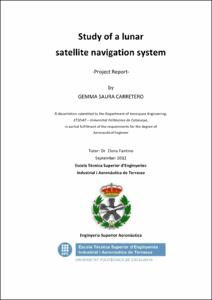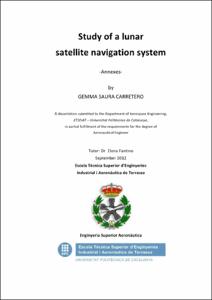Mostra el registre d'ítem simple
Study of a lunar satellite navigation system
| dc.contributor | Fantino, Elena |
| dc.contributor.author | Saura Carretero, Gemma |
| dc.date.accessioned | 2013-03-18T18:38:20Z |
| dc.date.available | 2013-03-18T18:38:20Z |
| dc.date.issued | 2012-09 |
| dc.identifier.uri | http://hdl.handle.net/2099.1/17684 |
| dc.description.abstract | The objective of the present study is to hold a preliminary analysis and design of a lunar global satellite navigation system able to provide accurate positional information to operators on the surface or in low lunar orbits. The outcome is a set of indications concerning the implications inherent in such a system. This set of indications consists in the main objectives, requirements and constraints needed during the definition and implementation of an infrastructure for global precise positioning on the lunar surface. In any preliminary mission analysis it is important to determine the design drivers. In our case, the main drivers are the orbital height, the number of satellites in the constellation, the orbital inclination and the number of orbital planes. These four parameters are the main characteristics that define the constellation performance, therefore their final selection is crucial for the mission success. In our case, two constraints have been applied in order to determine the constellation: (1) no more than three orbital planes and (2) no more than 18 satellites. The constellation selection process has been carried out with the help of computer simulation. Thanks to it, we were able to choose the constellation whose parameters combination resulted in the best performance. The final constellation has a height of 6500 km, three orbital planes, 15 satellites and an inclination of 90°. In order to maintain the correct performance of the constellation, a station-keeping strategy has been developed. Computer simulation of the chosen constellation allowed us to quantify the perturbation effects on the satellites and to identify which perturbation is the primary source of orbital deviations. Central body gravitation, third body-perturbations and solar radiation pressure have been computed for a period of one year with the result of a propellant (also known as Δv) budget of 1 km/s. Payload selection is an important step in the design process. The characterization of its mass, power and thermal requirements, and components influences the design of all the other subsystems. Relativistic effects on time are taken into account because the accuracy of the system depends on clock errors. The study concludes that, although relativistic effects on time are less significant on the constellation than on the terrestrial GPS system, they still need to be corrected. This study also undertakes a preliminary design of the satellite subsystems. Power and mass budget are made and a preliminary analysis of the propulsion, thermal and communications subsystems are also carried out. The proposed preliminary satellite design consists in a 1000kg-1600W class platform which will transmit in the L-band (to the lunar surface) and in the X-band (to the Earth). If the station-keeping is carried out by a bipropellant thruster, the propellant budget needed is 225 kg. However, some indications for electrical propulsion for the station-keeping maneuvers are also provided. The thermal environment is the biggest challenge of the mission because of the Earth eclipses1. They can last more than 5 hours which leads to the temperature getting as low as -35°C. During lunar2 eclipses, secondary batteries can produce around 1300 W which will probably not be sufficient to maintain the spacecraft temperature within operational limits during Earth eclipses, so an extra set of batteries will be needed. |
| dc.language.iso | eng |
| dc.publisher | Universitat Politècnica de Catalunya |
| dc.rights | Attribution-NonCommercial-NoDerivs 3.0 Spain |
| dc.rights.uri | http://creativecommons.org/licenses/by-nc-nd/3.0/es/ |
| dc.subject | Àrees temàtiques de la UPC::Aeronàutica i espai::Sistemes CNS/ATM (Communication, Navigation, Surveillance/Air Traffic Management) |
| dc.subject | Àrees temàtiques de la UPC::Enginyeria de la telecomunicació::Radiocomunicació i exploració electromagnètica::Satèl·lits i ràdioenllaços |
| dc.subject.lcsh | Atomic clocks |
| dc.subject.lcsh | Artificial satellites in navigation |
| dc.subject.other | System’s engineering |
| dc.subject.other | Constellation |
| dc.subject.other | Moon |
| dc.subject.other | Global satellite navigation system |
| dc.subject.other | Orbital perturbations |
| dc.subject.other | Atomic clocks |
| dc.subject.other | Eclipse |
| dc.title | Study of a lunar satellite navigation system |
| dc.type | Master thesis (pre-Bologna period) |
| dc.subject.lemac | Satèl·lits artificials en navegació |
| dc.subject.lemac | Òrbites |
| dc.subject.lemac | Constel·lacions |
| dc.rights.access | Open Access |
| dc.audience.educationlevel | Estudis de primer/segon cicle |
| dc.audience.mediator | Escola Tècnica Superior d'Enginyeries Industrial i Aeronàutica de Terrassa |
| dc.audience.degree | ENGINYERIA AERONÀUTICA (Pla 2004) |



